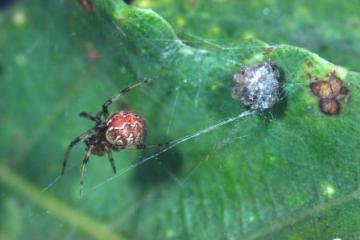Species Account for Theridion pinastri
Theridion pinastri L.Koch, 1872
Araneae: Theridiidae

Reproduction for study and non-profit use permitted, all other rights reserved.
Taxonomic group: spiders (Araneae) - County data
View time series maps for Theridion pinastri
member log-on for taxon report
Status: NR
Essex RDB: Listed
Threat: Essex Threatened
Images
upload a new image
National map for Theridion pinastri on Spider and Harvestman Recording Scheme website
Species text
The spider was first recorded in Britain as a male at Chobham Common, Surrey in 1977 with a female taken in the same vicinity in 1984. There have been a number of more recent records and further unpublished records in South Essex, West Kent and Surrey, with rather few specimens collected in Britain. The spider has previously been associated with mature heathland in Britain and pine woods on the Continent (Merrett in Bratton 1991). However, recent evidence suggests that mature broad-leaved trees such as large oak or beech in open situations at the edge of woodland clearings, acid grassland or heathland are more typical. Mature males and gravid females have been beaten off the lower branches of oak at Leyton Flats in South Essex and further males and females have been collected from large oaks in open habitat in South Essex and Hertfordshire, and from mature beech at Burnham Beeches in Buckinghamshire (Harvey et al. 1993, Carr & Harvey 1996, Carr 1998). However, in 1998 an adult female was also collected from scrubby oak in a hedgerow near Dartford Heath in West Kent and an adult male was taken in a pitfall trap set in a silt lagoon at Rainham Marshes in South Essex. Adults have all been found in the period from early June to mid-July except for a single female taken in October. Although most recent records involve mature broad-leaved trees, a common feature is an open habitat at the edge of clearings or widely spaced trees in open grassland or heathland. Lack of management resulting in the development of secondary woodland and the closure of open woodland is probably detrimental to this species. Management to retain open surroundings by light grazing or periodic control of scrub and tree invasion is likely to be important (Harvey et al. 2002). References
Habitats
Recorded management for locations with Theridion pinastri
Recorded substrate and hydrology for locations with Theridion pinastri
Why not join the Club, register and add a new species page
Interpretation of distribution maps



















